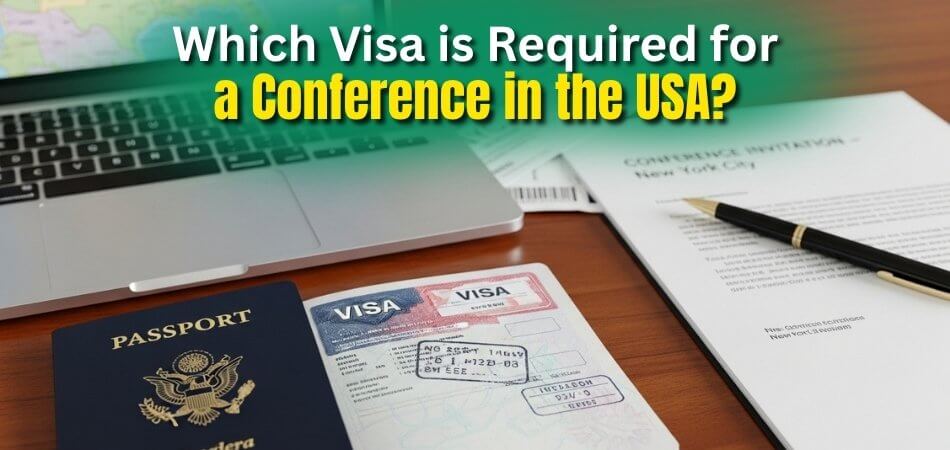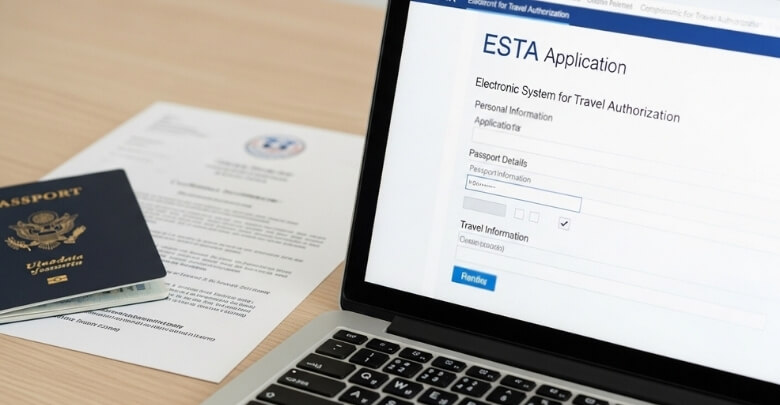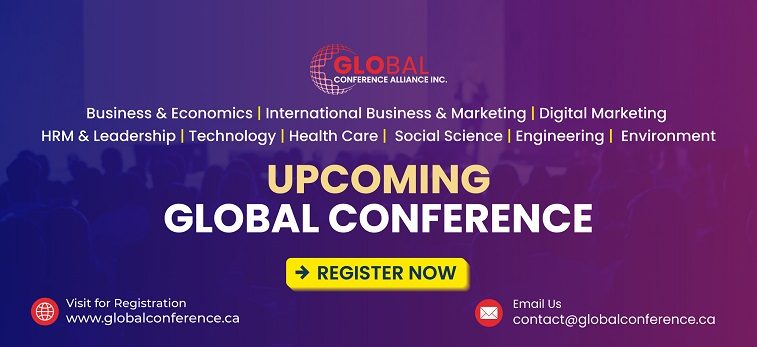Going to a conference in the United States can be exciting. You might be going to learn new things, meet people, or share your ideas. But before you go, it’s important to know what kind of visa you need. Many people are confused about this, but don’t worry — it’s easier than it seems.
So, you must be wondering which visa is required for a conference in the USA?
For most people, the B-1 Business Visitor Visa is needed to attend a conference in the USA. It allows short visits for events like meetings or seminars. Some students may need an F-1 or J-1 visa. People from certain countries can use the Visa Waiver Program with an ESTA for short trips.
Keep reading to find out which option is right for you.
Which Visa is Required for a Conference in the USA?
The most common visa for attending a conference in the USA is the B-1 Business Visitor Visa. It allows short stays for business activities like meetings, seminars, and academic or trade events. Students may need an F-1 or J-1 visa depending on their study-related conference plans. Citizens from Visa Waiver Program countries can apply for ESTA instead. To understand which option fits your situation, here are the main factors to consider.
Purpose of the Visit
Your purpose determines which visa fits best for attending conferences in the United States. The B-1 visa is most suitable for business-related conferences, trade shows, or professional seminars. It is not valid for receiving U.S. employment or payments during your stay. Students joining academic conferences may instead need a visa linked to their studies.
The J-1 Exchange Visitor Visa applies to exchange programs or training organized by sponsors. F-1 visas cover student conferences tied directly to academic work or research. If you are a recognized speaker, the O-1 visa may apply. Each visa category is designed for different participants and their specific conference goals.
Duration of Stay
The length of your trip is another key factor when selecting the right visa. The B-1 Business Visitor Visa allows a short stay, usually lasting up to six months. It provides enough time for events, networking, and related conference activities. For many professionals, this is the simplest option to consider.
Participants under the Visa Waiver Program (VWP) can stay for up to 90 days. This option is valid only for citizens from specific countries eligible for ESTA approval. Those needing longer stays must apply for a visa directly. Always match your travel plans with the visa’s allowed period to avoid issues.
Role at the Conference
Your role at the event strongly impacts the visa type you should apply for. If you are only attending, the B-1 visa often works best for business visitors. If you plan to present research linked to studies, an F-1 student visa may fit better. Keynote speakers with extraordinary ability sometimes qualify for the O-1 visa.
Participation type also shapes requirements, especially if recognition or sponsorship is involved. Government-supported exchange programs often require the J-1 visa. Attendees from VWP countries may attend events under ESTA approval for conference in USA. Choosing the right visa depends on whether you are a guest, student, or recognized contributor.
Country of Citizenship
Your country of citizenship can decide whether you require a visa or can use a waiver. Citizens from Visa Waiver Program countries can apply for ESTA online for entry. This approval allows short visits for conferences, meetings, and seminars without applying for a visa. Travelers from non-eligible countries must apply for the correct visa category.
Using ESTA can save time if your country participates in the VWP program. However, eligibility depends strictly on your nationality. Students or speakers from VWP countries may still need specific visas. Always confirm your country’s status before planning your travel and conference attendance.
Sponsorship and Payment Conditions
Conference sponsorship or financial arrangements may affect your visa requirements. The B-1 visa does not allow any U.S. payments for services. Participants who will receive direct U.S. compensation must apply for different visa categories. Failing to follow these rules can lead to immigration issues.
Government-sponsored exchange events usually require the J-1 visa for compliance. Speakers invited by institutions may qualify under the O-1 visa category. If funding is tied to academic studies, the F-1 visa is usually appropriate. Always match your financial arrangements with the correct visa guidelines for smooth entry.
What Are the Key Requirements for the B-1 Visa Include?
Traveling to the United States for business purposes requires specific preparation. The B-1 visa is the most common option. It is designed for meetings, events, and short-term professional activities. Below are the important requirements you must understand clearly before applying.
- Valid Passport: Your passport must remain valid for at least six months after your planned stay ends, ensuring smooth entry during travel. Border officials require a valid passport to confirm your identity, maintain accurate travel records, and verify proper visa documentation quickly.
- Conference or Meeting Proof: Applicants need documents that show a clear business purpose, like invitation letters, schedules, or confirmed registrations for professional events. These papers demonstrate your visit’s intent and assure officers that your trip is focused on non-employment business activities only.
- Financial Stability: You must show funds for accommodation, meals, and transportation, ensuring no reliance on unauthorized U.S. employment for covering expenses. Bank statements, income records, or sponsor letters often help confirm your ability to handle costs during the visit responsibly.
- Non-Immigrant Intent: Evidence must show you plan to return home after the trip, avoiding suspicion of permanent settlement attempts in America. Supporting documents like return flight bookings, employment letters, or property ownership help prove strong connections to your home country.
- No Paid Work: This visa does not allow U.S.-based employment or salary, only business visits without receiving money from American sources. Attending trade shows, networking, or consulting for overseas companies is fine, but working for American employers is strictly prohibited.
How to Apply for a B-1 Visa?
Applying for a B-1 Visa may seem complex, but the process becomes simple once you know the steps. Careful preparation helps avoid delays and ensures you meet the requirements. Follow this step-by-step guide to complete your application smoothly.
Step 1: Fill Out Form DS-160
Begin the process by completing the DS-160, the Online Nonimmigrant Visa Application form. Provide accurate details about your trip, background, and contact information. Save the confirmation page after submission because it is needed during the interview. Printing a copy ensures you carry a reliable backup for embassy requirements.
Step 2: Pay the Application Fee
After completing the DS-160, pay the non-refundable application fee of about $185. The cost may vary depending on the embassy location and local currency. Keep your payment receipt safe since you must show it for your interview. Without this receipt, scheduling or confirming an appointment will not be possible.
Step 3: Schedule the Interview
With your DS-160 confirmation and fee receipt, arrange your interview appointment. Choose the nearest U.S. Embassy or Consulate for convenience. Have your passport number, DS-160 barcode, and receipt number ready when booking. Plan ahead since appointment slots may fill up quickly, especially during busy travel seasons.
Step 4: Prepare the Documents
Collect all necessary papers before the interview date arrives. Bring your valid passport, DS-160 confirmation page, visa fee receipt, and appointment letter. Add supporting items such as your conference invitation, itinerary, and proof of financial resources. Evidence showing your ties to your home country also strengthens your case.
Step 5: Attend the Interview
On the interview day, arrive early and keep documents organized. The officer will ask about your purpose, background, and plans. Digital fingerprints are also taken during the process to confirm your identity. Questions may include details about your business meetings or the duration of the US conference visa request.
Step 6: Wait for Processing
If approved, your application moves into the final processing stage. The embassy informs you about when and how to collect your passport. This period can vary based on location and workload. Stay patient while checking official updates from the embassy until your visa is ready.
What Documents Prove Strong Ties to My Home Country?
When you apply for a U.S. visa, you must show proof that you will return home. Officers check if you have family, work, or property to go back to. These things prove you only want to visit. Having these papers we listed below makes your case stronger.
- Job Proof: A letter from your boss or company shows you have steady work waiting at home. Pay slips or contracts also help show you are tied to your job.
- Home or Land: Owning a house, apartment, or land proves you have roots in your country. Property papers show you are not planning to stay abroad.
- Family Documents: Marriage papers, children’s birth certificates, or parent details show strong family ties. These records prove you want to return home.
- Money Records: Bank books, savings papers, or investment details show you are financially settled at home. These documents prove you can support yourself.
- School Papers: Students can show letters from school or college confirming enrollment. This proves they must return to continue their studies.
Is it Possible to Attend a Conference Under the Visa Waiver Program ESTA?
Yes, you can attend a conference in the United States under the Visa Waiver Program with ESTA approval. Citizens from eligible countries may travel for short business activities like meetings or conferences without applying for a B-1 visa. The visit must stay within 90 days, and ESTA approval is required before departure. Travelers also need valid biometric passports from VWP countries to qualify. Here are the key rules and conditions you should know before planning your trip.
Length of Stay
The Visa Waiver Program only allows a stay of up to 90 days. Travelers cannot request an extension after arrival. This rule applies to all business visits, including conferences or seminars. Plan carefully so your schedule matches the allowed time.
ESTA Approval
Travelers must apply for ESTA online before leaving for the United States. Approval usually comes quickly, often within minutes. Without ESTA confirmation, boarding a flight is not possible. Always check the validity period before scheduling your trip.
Passport Requirement
Only biometric passports from Visa Waiver Program countries qualify for ESTA use. The passport must remain valid during your stay. Expired or damaged passports result in denied entry at the border. Keep your documents current to avoid problems during travel.
Restrictions on Use
ESTA approval does not allow paid employment in the United States. It only covers short, temporary business or tourist visits. Travelers cannot change their visa category once inside the country. For longer stays or employment, a different visa is necessary.
Non-VWP Citizens
Citizens from countries not included in the Visa Waiver Program cannot use ESTA. They must apply for the B-1 visa instead. This process involves completing DS-160, paying the visa fee, and attending an interview. Each step ensures proper documentation before attending a conference.
How Long Does B-1 Visa Processing Take in My Country?
The processing time for a B-1 visa depends heavily on the U.S. Embassy or Consulate handling your case. Submitting the DS-160 form happens instantly, while scheduling the Visa Application Center appointment usually takes one to two weeks. After that, the interview is normally available within one to three weeks, depending on the location. Once complete, visa stamping and passport return often require about five to ten working days.
Overall, most applicants finish the process within two weeks to two months depending on local embassy workloads. Some travelers wonder if it is easy to get a visa for conference in the USA, but timing matters more. Applying at least six to eight weeks before your trip helps avoid stressful last-minute delays. This buffer also gives space for extra processing, especially if additional checks are needed during your application review.
Frequently Asked Questions About the Required Visa for Conferences in the USA
Attending a conference in the United States requires the right visa based on your purpose, nationality, and role. Many travelers are unsure of the specific rules. These FAQs simplify the process and clear common doubts.
Can I Use a Tourist Visa to Attend a Conference?
A tourist visa (B-2) generally does not cover professional conference attendance. The correct visa is the B-1 Business Visitor Visa, which allows participation in events, meetings, and seminars. Always choose the right category to avoid legal issues.
Do I Need a Visa if I Am Only Speaking at a Conference?
Yes, speakers still require the correct visa, often the B-1 or sometimes the O-1 visa if highly distinguished. The category depends on your recognition, sponsorship, and whether your participation includes receiving honoraria or specialized awards.
Is an Invitation Letter Required for a B-1 Visa Application?
While not always mandatory, an official invitation letter from the conference organizers strongly supports your application. It shows a clear intent and purpose of travel, making it easier for consular officers to understand your temporary business visit plans.
Can I Bring My Family With Me on a B-1 Visa?
The B-1 visa does not include dependents, so family members must apply separately. They often apply for B-2 visas for tourism. Each member must show eligibility and purpose for travel when attending alongside the primary conference attendee.
Can I Extend My Stay Beyond the Conference Dates?
No, the B-1 visa does not allow long extensions beyond the permitted period. Applicants must leave before visa expiration. Overstays can damage future applications, so plan travel dates carefully and ensure you comply with U.S. immigration regulations.
Is It Possible to Switch to a Work Visa After Entering on B-1?
Switching to a work visa from B-1 status while in the U.S. is extremely limited. The B-1 category only permits temporary visits. If employment opportunities arise, travelers must apply for the appropriate work visa outside.
Do I Need Proof of Finances for the B-1 Visa?
Yes, consular officers often ask for proof of financial ability to cover travel expenses. This may include bank statements, salary slips, or sponsor documents. Strong financial evidence ensures you can manage your stay without depending on unauthorized work.
Can I Attend Multiple Conferences With a Single B-1 Visa?
Yes, a B-1 visa allows attending more than one conference within its validity period. Applicants should carry schedules and confirmations for all events. However, travel must remain within the visa’s authorized dates and intended business purposes.
Will a Student Attending an Academic Conference Still Need a B-1 Visa?
Not always. Students may qualify under their existing F-1 or J-1 visa if the event is study-related. If not covered, they must apply for a B-1 visa to participate officially in academic conferences or presentations.
How Early Should I Apply for a B-1 Visa Before My Conference?
Applicants should start at least six to eight weeks before their planned travel date. This allows time for appointments, interviews, and possible delays. Early applications ensure the visa process completes smoothly and avoids last-minute travel complications.
Concluding Thoughts
Attending a conference in the United States can open doors to new ideas, collaborations, and professional growth. Choosing the right visa is key to ensuring your trip goes smoothly and without stress. For many, the B-1 visa is the standard option, while students or exchange visitors may need different categories.
Travelers from eligible countries can also use ESTA for short visits. If you have ever wondered which visa is required for a conference in the USA, the answer depends on your role, duration, and nationality. By planning early and preparing documents carefully, you can focus on enjoying the experience.








